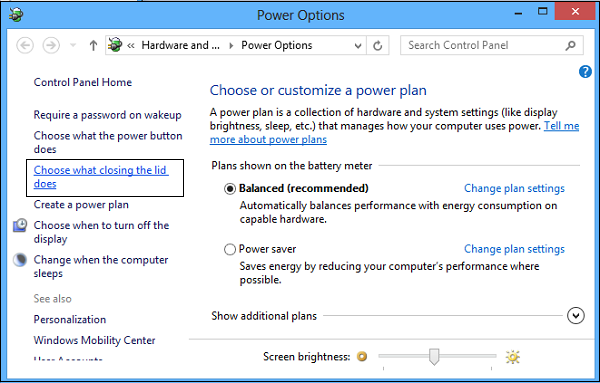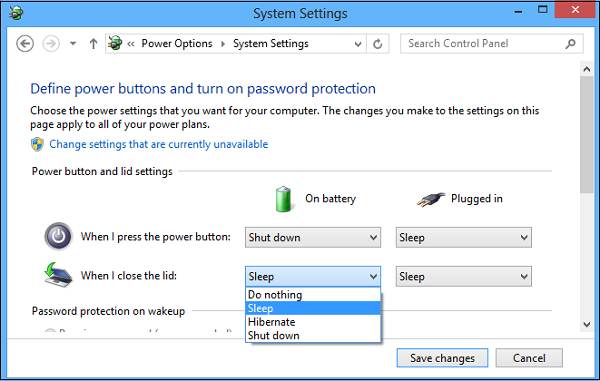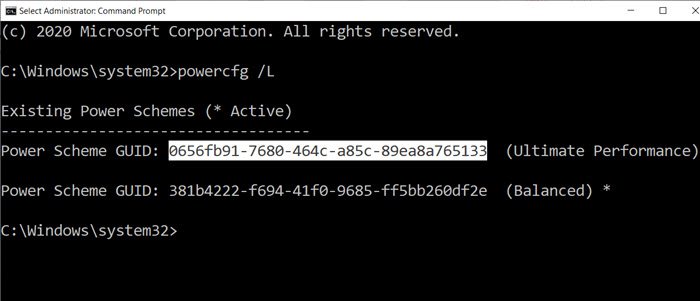These days most of us simply prefer to close the lid of our Windows 11/10 laptops once our work is over. Closing the laptop lid can result in your Windows shutting down, sleeping or hibernating. You can control the behavior and decide what you want to do, once you close the lid.

Some man laptop users want to close the lid but do not want the laptop to get into sleep mode. Windows is built to respond to the closing of the lid by putting the computer into sleep mode. This saves battery, and the work can be resumed as soon as you lid up. Users want to keep running programs in the background, but since the display consumes a lot of battery, they want it to be off. One way of doing this is to dim the display or disable this setting.
Most of us are aware that there are particularly 3 methods for powering down your new Windows 11/10 PC.
- You can make the PC sleep
- You can hibernate the PC
- You can turn it off completely
The Sleep option consumes little power to help your PC wake up faster and in no time so that you are back to where you left off. Chances of losing your work due to battery draining are minimized to zero in the Sleep mode as the OS automatically saves all your work before turning off your PC when the battery is too low. This mode is often brought into use when a person is away from his desk just for a while. Say, for a coffee break or while getting some refreshments.
The Hibernate option, in comparison to the Sleep mode, uses even less power and lands you at the same position where you last left off. The option, however, should be used when you are aware that you won’t use your laptop for an extended period.
Read this post if you are unsure whether you want to select Hibernate or Shutdown and here to see the difference between Sleep & Hibernate.
As mentioned. is it possible to push your laptop to any of the three power states described above, by simply closing the lid of your machine? Let us in this post learn how to shut down, hibernate, sleep Windows PC by closing the lid of your laptop.
Laptop settings – When you close lid
Press Win+R in combination to open the Run dialog. In the box, type powercfg.cpl and press Enter. This will open the Power Options applet of the Control Panel.
Now, in the Power Options window that opens up, click ‘Choose what closing the lid does’ link from the left side panel.

Choose what closing the laptop lid does
Choose what you want your laptop to do, when it’s running on battery and when it’s plugged in. For instance, under the Power button and lid settings section, you can find ‘When I Close the Lid’ option. Adjacent to it you can find options to help you define power button or lid settings.

You can choose from Do Nothing, Sleep, Shutdown, and Hibernate.
You should choose Shut down if you want to shut down Windows as soon as you close the lid. Select the desired option and click Save changes to save the settings.
In a similar fashion, you can also Change what the Power Button does when you press it.
See this post if Choose what closing the Lid does option is missing.
How to set what happens when you close the laptop lid using PowerCFG
Powercfg is a useful utility if you need to change the power setting quickly across the profile without opening the interface. If you have multiple computers at home and need to change settings on each, this is definitely handy. This post will guide how you can set what happens when you close the laptop lid using powercfg in Windows 10.

The first step in this method is to figure out the number of power plans you have on the computer and then change the setting for each of them. Close lid actions offer four methods—Nothing, Sleep, Hibernate, and Shutdown.
Open Command Prompt with admin permission, and then type the command powercfg /L to view all the plans.
It will display a list of GUIDs along with power names. Make sure to note the GUID for which you want to change. An asterisk marks the active or the current plan.
Since laptops run on battery and direct power, you will have to make changes for both or at least one based on your requirement.
We will use two options with the powercfg command:
- -setacvalueindex
- -setdcvalueindex
AC means when the laptop is plugged and DC means when it is running on battery.
powercfg -setdcvalueindex <GUID> 4f971e89-eebd-4455-a8de-9e59040e7347 5ca83367-6e45-459f-a27b-476b1d01c936 <LIDValue> powercfg -setacvalueindex <GUID> 4f971e89-eebd-4455-a8de-9e59040e7347 5ca83367-6e45-459f-a27b-476b1d01c936 <LIDValue>
Where GUID is from the above command, and LIDValue can be 01,2,3 and 4.
- 0 = Nothing
- 1= Sleep
- 2= Hibernate
- 3= Shutdown
It is important to note that GUID may change from computer to computer, and it is always a good idea to find out the exact GUID and then make the change. If you need to change it often, create a batch file and execute it as per need.
Keep laptop running with the lid closed
If you want to keep your laptop running even with the lid closed, select Do Nothing. See this post if you want to charge your Phone in Sleep Mode with the Laptop lid closed.
Can I leave my laptop on sleep mode overnight?
Yes, it’s completely safe to keep your laptop in sleep mode overnight or for 8-10 hours. It won’t drain the laptop battery a lot. Since only the memory consumes battery in sleep mode, there will be around a 5-10% drop in your laptop battery. However, you should use sleep mode for a short break (say 15-30 minutes) and use hibernate mode if you need to leave your laptop for hours and you won’t get the time to charge your laptop.
What are the disadvantages of hibernating computer?
Hibernation mode needs a good amount of hard disk space as the size of the hiberfil.sys (file that stores the content of current memory) file could be in GBs. Your laptop or desktop needs more time to resume your session as your current session is stored on the hard disk (instead of memory). In case of power loss, the unsaved data is lost. Other than that, hibernation mode is a good option to use when you need to leave your system unattended for hours.
Do let us know how you have set your Windows to behave when you close the laptop lid.
Read next: How to change Laptop Lid Open Action in Windows.
I have set win 8.1 to “do nothing” when I close the lid, but if I let the laptop go to sleep or put it to sleep myself, I can’t wake it. If the lid stays up, I am able to wake
lets say if i use sleep and i move around for a while is it bad for the laptop, and is it bad for the computer to hibernat and sleep insted of shutdown what does it do to the laptop is it bad on the long run!
Very helpful…. That’s why it did nothing when i closed the lid! Now i found out from this site. Thanks.
Hi everyone . I have a Dell Latitude 3540 running on Windows 8.1 Pro . I have set all the settings(with power and without power) to go to sleep but everytime I close the lod, my laptop shuts down .
Please Help
Your laptop seems to shutdowm, when put to Sleep. Please see if any of these hep you:
https://www.thewindowsclub.com/sleep-mode-not-working-windows-8-1
https://www.thewindowsclub.com/hibernate-shuts-down-computer
Hello,
We are selling a laptop in a service kit for our company. We want to make sure the computer shuts down when the lid is closed so that it does not overheat when the customer puts it back into the service kit case. We will configure the laptop to shutdown when the lid closes, but is there a way to lock that setting so that the customer can’t change it back?
Thanks,
Josh
OK I have a win 8 laptop and its usually always on, just sleeping at night. When I try to wake it in the morning by clicking the external keyboard, it wakes but the external screen doesn’t and I usually have to open the lid a little and let it close back. But now even that is not working. How can I get my monitor to wake up with my laptop??
My display gets completely corrupted when I wake from sleep. I haven’t tried hibernate though. If that doesn’t work, I may just set it to Do Nothing like I did with my old laptop.
EDIT: Hibernate seemed to work. Try that. What that does is similar to sleep mode. It puts everything that’s in your RAM into your hard drive, but it then shuts your computer down. So once you open it, you would have to press the power button, then it will go right back to where you were after you log in. :P
please when i shut down the laptop i can not open it without remove the battery and return battery in my laptop
Okay i have a dell inspiron 15r and its 8.1. if i close the lid (and this is set to sleep) i have to press power for it to turn on again/ wake up from sleep
Is there a way to set in the registry what happens when the lid is closed?
My dell laptop consume power even when I shut it down. If leave the battery fully charged at night and I shut it down, in the morning there is no power, and if I remove the battery after shutting down and immediately put it back, I find it has power still. Please help.
my drop box not showing sleep mode it only showing do nothing,hibernate,shut down plz suggest something
I have mine set to sleep when I close the lid but it still shuts down?
I want my laptop to keep running when the lid is closed, but to ask for the password when it is opened again.
Wasn’t there a setting for this before?